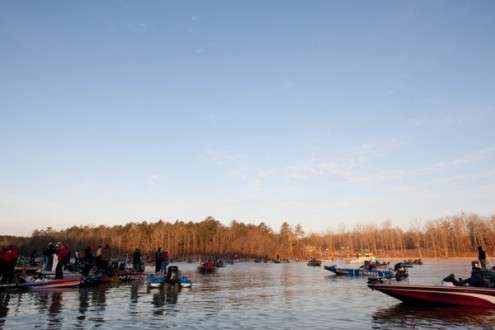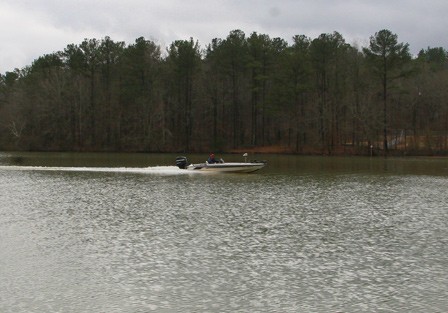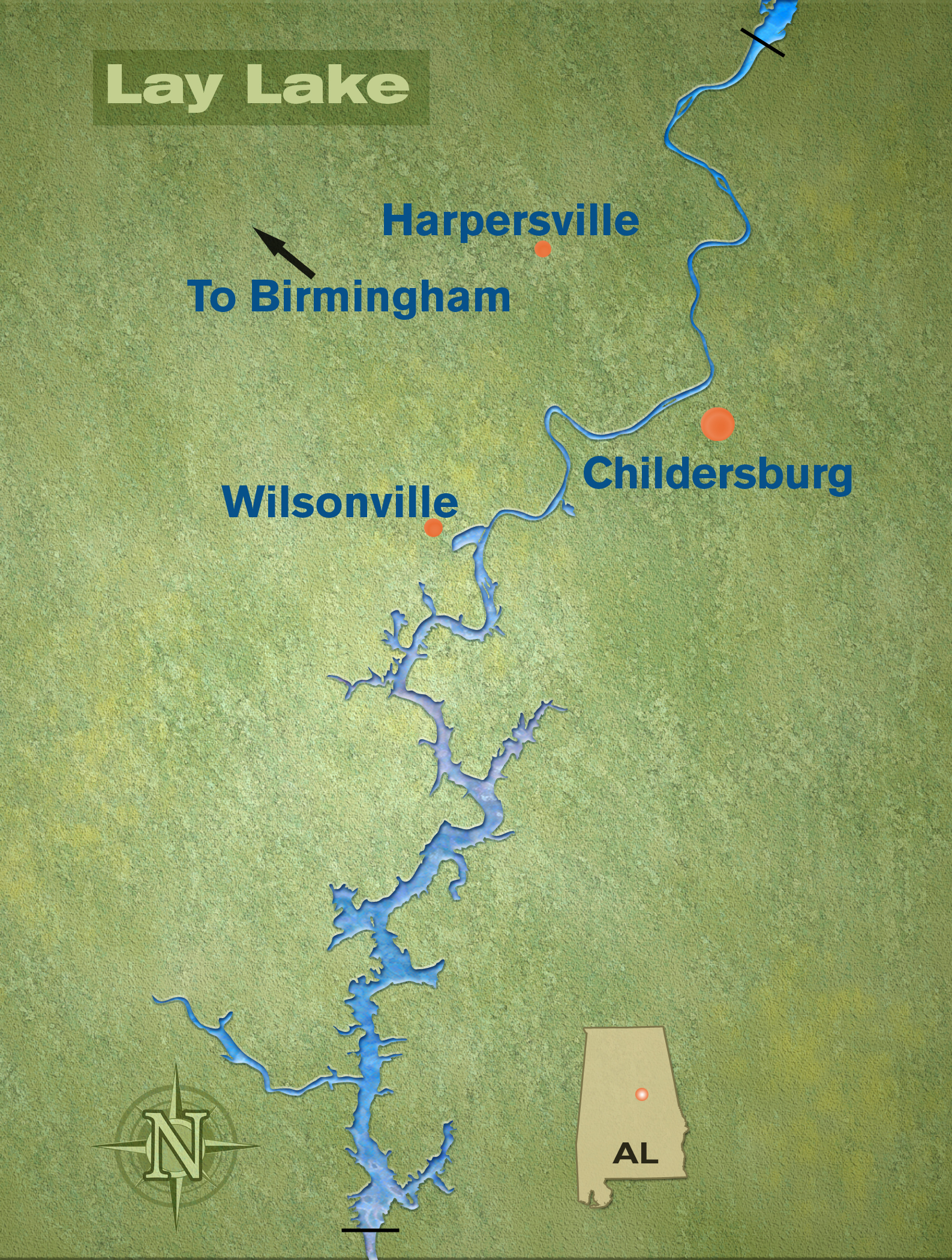
Given Lay Lake’s excellent bass fishing, you may find it hard to believe that this storied 12,000-acre reservoir celebrates its 100th birthday next year. Conveniently located 35 minutes south of Birmingham off of I-65, Lay Lake has played host to countless major bass tournaments. That includes the 2007 Bassmaster Classic, which was won by Bassmaster Elite Series pro Boyd Duckett.
Although Duckett won the Classic during the month of February, he has also enjoyed superb fishing at Lay Lake in other seasons.
“Even in the hot summertime, Lay produces five-bass tournament limits that go 17 to 19 pounds,” Duckett says.
The dilemma you face when you venture here is whether to fish for largemouth or mean-spirited Coosa River spotted bass. Largemouths up to 18 inches are abundant. Feisty spotted bass up to 18 inches are even more prevalent. Either way, you’ll get plenty of action with quality bass and catch moderate numbers of larger fish.
Duckett has devised three reliable patterns that will keep you in touch with Lay Lake’s bass in August. One of them will do the trick, whether you are fishing the upper, middle or lower section of the lake. Seven public access areas allow you to launch close to the type of fishing you prefer, saving time and costly boat fuel.
Largemouths below the Narrows
“You can always catch shallow largemouths in the summertime on the lower end of Lay Lake,” Duckett says.
The largemouth bass hang in pockets below a stretch of the lake known as the Narrows, Duckett points out. The most productive pockets have deep creek channels. You’ll find the bass within the first 500 yards of the creeks in water willows.
Water willows typically grow near the bank not much deeper than 2 feet. The most productive patches of this aquatic vegetaion have deep water nearby. If Duckett’s boat is floating over 4 feet of water when he’s pitching to water willows, he knows he’s working over grass that has high bass potential.
 In the morning, Duckett picks off active bass by working the water willows over with a weedless frog and a swim jig. When the sun gets up, the bass shut down and nestle into the vegetation. This is when many fishermen abandon the water willows and fish for spotted bass.
In the morning, Duckett picks off active bass by working the water willows over with a weedless frog and a swim jig. When the sun gets up, the bass shut down and nestle into the vegetation. This is when many fishermen abandon the water willows and fish for spotted bass.
Duckett continues to catch bass in the water willows by flipping a Yamamoto Flappin’ Hog with a 3/8-ounce bullet weight and 17-pound Vicious 100% Fluorocarbon line. When a more finesse presentation is needed to coax bites, he opts for a Senko with a 1/16-ounce or 1/8-ounce bullet sinker fished on 12-pound fluorocarbon. With either bait, he flips only a foot into the grass as the bass station themselves on the outside edge.
“You’ll catch the biggest summertime bass from Lay Lake in the water willows,” Duckett says.
Deep River-Turn Spots
Wherever the river channel makes a turn on the main lake, spotted bass cluster on the upstream sides of humps and creek-mouth depressions. Prime feeding time is when Alabama Power generates electricity. The resulting current turns on the bass.
“The spotted bass are 18 to 25 feet deep, because that’s where the shad are in the summer,” Duckett says.
Duckett gets down to the bass with a fast sinking Silver Buddy, a metal vibrating blade bait. He casts upstream or quartering upstream, lets the Silver Buddy sink to the bottom and works it back with a sweep-drop retrieve.
“Just pull the bait up hard enough to make it vibrate,” Duckett advises. “You don’t want to rip it off the bottom
A drop shot rig also scores for Duckett. He dresses a No. 3 drop shot hook with a 4-inch Yamamoto Shad Shape and fishes it on 8-pound fluorocarbon with a 1/4-ounce weight.
“I’ll drop the bait straight down if I see a bass on my depthfinder,” Duckett says. “But I usually pitch it out a short distance and work it back over the bottom.”
Upriver Option
“I’ve won tournaments at Lay Lake by running upriver,” Duckett said. “The bass are current oriented when you get within about 10 miles of the Logan Martin Dam.”
When the current flows, the big spotted bass that thrive in this stretch go on the prowl. Duckett takes full advantage of the feeding spree by pitching a 7/16-ounce 4×4 Jig dressed with a Strike King Rage Tail Chunk. He threads the chunk onto the hook’s shank to keep it compact. A small profile jig appeals to spotted bass, and it creates less drag in the current than a bulkier jig.
Pitching the jig to the bank pays off in the spring, but not in the summertime, Duckett stresses. Now you’ll get more bites in 6 to 8 feet of water. Try crankbaits and topwater lures when the current isn’t flowing.
OTHER SPECIES
 Besides top notch fishing for spotted bass and largemouths, the tailwater below Logan Martin Dam is also excellent for hybrid striped bass and catfish. Striped bass are also taken here. The fishing for all species is best when the hydroelectric dam pulls water and creates a current. Top find out the daily generation schedule go to: lakes.alabamapower.com.
Besides top notch fishing for spotted bass and largemouths, the tailwater below Logan Martin Dam is also excellent for hybrid striped bass and catfish. Striped bass are also taken here. The fishing for all species is best when the hydroelectric dam pulls water and creates a current. Top find out the daily generation schedule go to: lakes.alabamapower.com.
BEFORE YOU GO
Visit alabamabasstrail.org before you visit Lay Lake or any Alabama reservoir. Here you’ll find detailed information about nine lakes and two major river systems, including fishing locations, productive fishing patterns, local guides, campgrounds and where to stay.
HABITAT GPS COORDINATES
The Alabama Power Company improved the fishing at Lay Lake by providing habitat. Coordinates of these habitat improvements are available as an Excel spreadsheet or a GPS Download.





